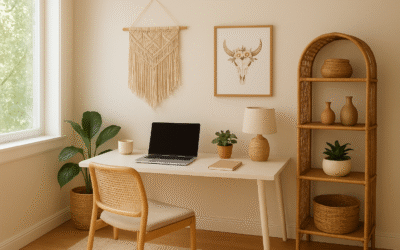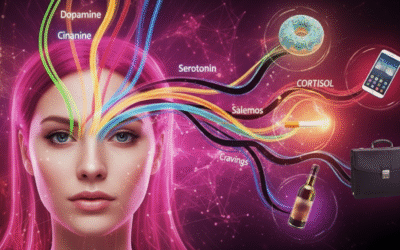Do You Believe Organizing Your Space Can Rewire Your Brain for Success and Well-being?
In the continuous hustle and bustle of our daily lives, our surroundings DO play a silent, yet powerful, role in shaping our mental and emotional landscape.
A mountain of unsorted mail 📬, a desk buried under files 🗂️, or a living room simmering with a chaotic array of possessions 🌪️ can be more than just a physical nuisance; it can be a significant, even if often unrecognized, source of stress!
Conversely, a thoughtfully organized, clean, and aesthetically pleasing environment can act as a potent elixir for our well-being, fostering a cascade of positive hormonal responses that enhance our lives both at home and at work. 🏠🧑🏻💼
For as long as I can remember, a messy or poorly decorated room has felt like a direct assault on my inner peace! 👼🏻
It’s a visceral reaction, an almost electric hum of anxiety that starts in my chest and spreads outwards, making it impossible to focus or even just to breathe deeply. It’s not about being a “neat freak”; it’s about the fact that the external chaos seems to instantly amplify any internal turmoil. All my inner demons were silent, and suddenly they all wake-up and come out to get me. 👿👿
My mind, which already runs a mile a minute, suddenly feels like it’s navigating a minefield of unfinished tasks and visual noise. This isn’t just a feeling; it’s a physiological response. When I’m surrounded by clutter, I can almost feel the surge of cortisol, my body’s own stress alarm system, going into overdrive.
This hormonal cascade is a remnant of our survival instincts, signaling a loss of control and an environment that isn’t safe or settled.
So, even in a space that isn’t my own—at a friend’s house for a short vacation, for example—my brain craves the order that brings a sense of calm and predictability, a decorated corner or a neatly arranged stack of books becoming a small anchor in the storm of an otherwise untidy space. 📚🎍🖼️
It’s a reminder that while the world around me might be in disarray, I can still cultivate a pocket of tranquility for my own well-being.
If I tell you I can’t concentrate on my work if my workspace and my desk aren’t organized (my personal sense of organization, of course) and appealing, does it sound stupid?
How can a pink and purple keyboard and mouse set or a colorful computer desktop help me be better at my work? It seems so futile!
But for the creative mind of an adult ADHDer pretty things and vibrant colors can improve focus! Why?
Dopamine is a neurotransmitter that plays an important role in ADHD, though it’s not the only contributing factor.
Research indicates that low dopamine levels may be linked to symptoms such as trouble focusing, impulsivity, and lack of motivation. So, now you get it!
But both for the neurodivergent and the neurotypical, the connection between our external world and internal state is not merely anecdotal; it is a scientifically supported phenomenon.
When confronted with a cluttered and disorganized space, our brains are bombarded with an excess of stimuli. 🤯
This visual “noise” competes for our attention, leading to cognitive overload and a diminished capacity for focus and information processing.
A state of perpetual low-grade chaos can trigger the release of cortisol, the body’s primary stress hormone.
Elevated cortisol levels, even at a subtle, chronic rate, can contribute to feelings of anxiety, fatigue, and a growing sense of being overwhelmed. For many, this stress creeps along in the background of their lives, an unseen creature influencing their mood and behavior.
In contrast, the act of creating order from chaos—of organizing, cleaning, and curating our environment—can trigger the release of a cocktail of “well-being hormones.”
The satisfaction of completing a task, even one as simple as making the bed or clearing a countertop, can provide a hit of dopamine, the neurotransmitter associated with pleasure and reward. This creates a positive feedback loop, motivating us to maintain an organized space.
Furthermore, an environment that is clean, calming, and aesthetically pleasing can contribute to the release of serotonin, a neurotransmitter crucial for mood stability, feelings of calm, and overall well-being.
Do you have a neighbor or aunt who is obsessed with tidiness? This is what lies at the root of compulsive behavior related to cleaning and tidying up.
Do you know The Sims game? It’s a famous simulation game being played all over the world by people of all ages since 2000. What does it simulate? It’s a social simulation game where players control virtual people (“Sims”) and manage their lives. Your Sims will have desires, aspirations, fears, hunger and need to sleep, have baths, even socialize and have fun. The player must satisfy all their needs so that nothing bad happens.
One factor to consider while playing is that the sims’ mood deteriorates when they are in dirty or poorly decorated environments and improves as soon as we improve the order, cleanliness and decoration of their spaces.

While the direct causal link is still being explored by neuroscientists, the psychological benefits of a structured environment—a sense of control, predictability, and safety—are known to foster a mental state conducive to serotonin production.
This hormonal shift has profound implications for our personal and professional lives.
At Home: Cultivating a Haven of Harmony
A disorganized home can be a breeding ground for familial tension. The constant visual reminders of undone chores and the frustration of not being able to find things can shorten tempers and create a backdrop of chronic stress.
This can strain relationships, leading to more frequent arguments and a diminished sense of peace.
By actively working to create an organized and inviting home, families can foster a more harmonious environment. The process of decluttering and organizing, when undertaken collaboratively, can even become an exercise in teamwork and communication. It provides an opportunity to discuss shared values and priorities, strengthening family bonds.

A well-ordered home reduces the daily friction that can erode relationships. With less time spent searching for lost items and a clearer division of responsibilities for maintaining order, there is more mental and emotional space for positive interactions. This calmer, more predictable environment can also be particularly beneficial for children’s development, providing a sense of security and stability that is essential for their emotional well-being.

A home that feels like a sanctuary can also encourage the release of oxytocin, the “bonding hormone,” through shared moments of relaxation and connection.
At the Workplace: Engineering Productivity and Satisfaction
The principles of an organized environment are equally critical in the workplace, if not more.
A cluttered and poorly designed office can be a significant drain on productivity. People waste valuable time searching for documents or navigating a chaotic workspace, leading to frustration and inefficiency. The constant visual distractions can make it difficult to concentrate, hindering deep work and creative thinking.

Progressive companies are increasingly recognizing the strategic advantage of investing in a well-organized and aesthetically pleasing work environment.
This extends beyond simple tidiness to encompass thoughtful office design, including elements of biophilic design—incorporating nature into the built environment—and neuroarchitecture, which considers the psychological and neurological impact of spaces on their inhabitants.

An organized and inspiring workplace can lead to a tangible increase in productivity. When employees have a clear and efficient workspace, they can focus more effectively on their tasks.
A sense of order and control over their immediate environment can boost morale and job satisfaction.
So, companies that prioritize a positive work environment often report higher levels of employee engagement, reduced absenteeism, and lower turnover rates.
This investment in the physical workspace is an investment in the company’s most valuable asset: its people.


A workplace that promotes well-being sends a powerful message to employees that they are valued. This fosters a more positive and collaborative company culture, where individuals feel motivated and empowered to perform at their best.
Ultimately, this translates to increased innovation, improved client relationships, and a stronger competitive edge.
In conclusion, the state of our surroundings is not a trivial matter. It’s a powerful lever that can be used to influence our stress levels, elevate our mood, and enhance our overall quality of life.
By consciously curating our homes, home offices and workplaces to be organized, clean, and inspiring, we are not just tidying up; we are actively rewiring our brains for greater peace, satisfaction, and success. The path to a less stressful and more fulfilling life may just begin with clearing your desk. Try it!
(Images made by the Verbarium Team with ChatGPT)
Read more:
YouTube
The Relationship Between Corticol and Anxiety
https://www.youtube.com/watch?v=xWxr5tz_HWo
Cleveland Clinic
Dopamine.
https://my.clevelandclinic.org/health/articles/22581-dopamine
👉🏼 Need professional translation services, proofreading services, localization & transcreation services or copywriting services?






0 Comments